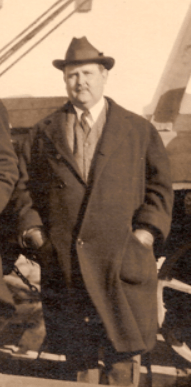John V. Dittemore
| John Valentine Dittemore | |
|---|---|
 | |
| Born |
September 30, 1876 Indianapolis |
| Died |
May 10, 1937 New York |
| Occupation | Christian Science director, writer |
John Valentine Dittemore (September 30, 1876 - May 10, 1937) was an American biographer and writer. He was a director of The First Church of Christ, Scientist, the Christian Science church, in Boston from 1909 until 1919. Before that he was head of the church's Committee on Publication in New York, and a trustee for ten years of the estate of Mary Baker Eddy (1821–1910), the founder of Christian Science.[1]
Dittemore is best known as the co-author, with Ernest Sutherland Bates, of Mary Baker Eddy, the Truth and the Tradition (1932). Historian Ralph Henry Gabriel wrote in 1933 that, because of the amount of primary-source material to which Dittemore had access, the book "comes very close to being a definitive history of a strangely paradoxical woman".[2]
Background
Dittemore was born in Indianapolis. He attended Ohio Military Institute and Phillips Academy Andover. He was president of the Federal Packing Company and Vice-President of Van Camp Packing Company.[3] He married Edith L. Bingham in 1898, they had one daughter, Louise.[3]
As head of the Christian Science church's Committee on Publication, Dittemore commissioned the first church-authorized biography of Eddy, The Life of Mary Baker Eddy (1907) by Sibyl Wilbur, which he later said was unreliable. Over the next 20 years he collected primary-source material about the church and Eddy. As his research progressed, he began to find material, including thousands of letters Eddy had written, that in his view contradicted the church's account of its own history and Eddy's life. The church at first supported his research, then tried to dissuade him from continuing with it.[4]
He became disillusioned with the church after coming to the view in 1928 that Eddy's work, much of it in the religion's textbook Science and Health (1875), had borrowed heavily from the unpublished manuscripts of New England "mental healer" Phineas Parkhurst Quimby (1802–1866). He was also concerned that the church had attempted to boycott Charles Scribner's Sons for publishing a critical biography of Eddy, Edwin Dakin's Mrs. Eddy: The Biography of a Virginal Mind (1929).[4][2] The publisher took out an ad in the Los Angeles Times in December 1929 saying that booksellers across America were returning Dakin's book under pressure. It said: "The result is a situation almost incredible in a free country."[5]
Mary Baker Eddy, the Truth and the Tradition
Dittemore went on to write his own biography of Eddy and history of the church, Mary Baker Eddy, the Truth and the Tradition (1932), with the historian Ernest Sutherland Bates. That he collaborate with Bates was suggested by Allen Johnson, Professor of American History at Yale University.[4]
The book is largely based on three trunks full of primary sources that Dittemore collected, including 1,500 unpublished letters from Eddy; rare excerpts from the diary of Eddy's personal assistant Calvin Frye; the diary of James F. Gilman, who illustrated her work; letters from her brother and first two husbands; 500 letters from her students; and reminiscences from her close contacts.[4] Gillian Gill writes that Dittemore, on behalf of the church, gained access to Frye's rooms after his death and removed sections of his diary, which Vittemore transcribed, photographed, then burned. He included extracts in his book.[6]
The work also makes use of two books that Dittemore writes were suppressed by the church: Mrs. Eddy as I Knew Her in 1870 (1923) by Samuel Putnam Bancroft, a student of Eddy's, and Mrs. Eddy and the Late Suit in Equity (1908) by Michael Meehan. The latter is about a lawsuit Eddy was involved in toward the end of her life, in which her relatives sought unsuccessfully to have her declared unable to manage her affairs.[4] Meehan was a supporter of Eddy's, and she initially approved the publication but later asked the author not to release it.[4][7]
Just as the church had suppressed other works critical of Eddy, it also suppressed the Truth and the Tradition by buying the copyright and publisher's plates from A. A. Knopf.[8]
Publications
- Dittemore, John V. (1925). The Evolution of Christian Science: A Brief Summary of Its Historical Development, Contemporary Attainments, and Future Destiny. (Publishing Society of the Christian Science Parent Church).
- Bates, Ernest Sutherland and Dittemore, John V. (1932). Mary Baker Eddy, the Truth and the Tradition. New York: A. A. Knopf (London: George Routledge & Sons, 1933).
Notes
- ↑ Gabriel, Ralph H. (March 1933). "Mary Baker Eddy, the Truth and the Tradition by Ernest Sutherland Bates; John V. Dittemore". The New England Quarterly. 6 (1): (200–202), 200. JSTOR 359379.
- 1 2 Gabriel 1933, 202.
- 1 2 Thompson, Donald Eugene. (1974). Indiana Authors and Their Books 1917-1966. Wabash College. p. 169
- 1 2 3 4 5 6 Truth and the Tradition, iv.
- ↑ Duffield, William (20 December 1929). "Mrs. Eddy: The Biography of a Virginal Mind", letter to the editor, California and Western Medicine, 20 December 1929. PMC 1657341
- ↑ Gill, Gillian (1998). Mary Baker Eddy, Perseus Books, 576.
- ↑ Meehan, Michael (1908). Mrs. Eddy and the Late Suit in Equity. Concord, NH. Another edition is entitled Mrs. Eddy and Next Friends.
- ↑ Braden, Charles S. (1958). Christian Science Today: Power, Policy, Practice, Southern Methodist University Press, 384–385, cited in Gill 1998, 579.
Further reading
- "Asks court to oust Eddy publishers", The New York Times, 10 April 1919.
- "John V. Dittemore papers concerning Mary Baker Eddy 1850–1931", New York Public Library Archives & Manuscripts.